Peugeot 2008 1.2 PureTech EAT8
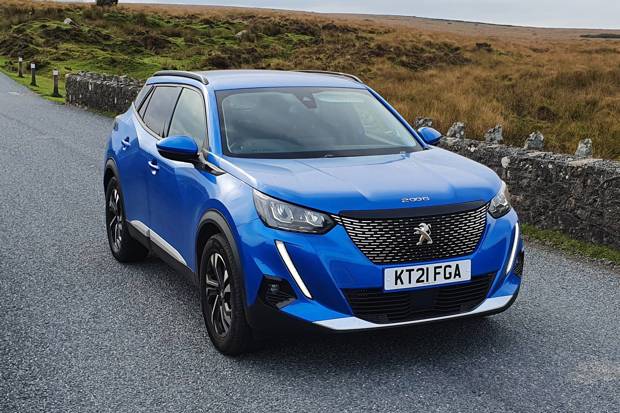
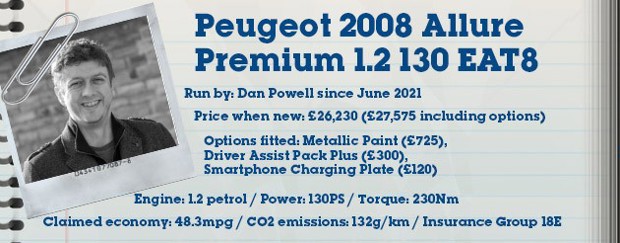
- Meet our long term review Peugeot 2008
- Out with the old and in with the new - why the 2008 SUV is the best yet
- Stop-start problems with the 2008
- When should you change the cam belt on the Peugeot 1.2 PureTech?
- Peugeot Connected 3D Navigation - do you really need it?
- Why are small SUVs like the 2008 so popular?
- Sofa, so good - why the 2008 is the small SUV with the big boot
- Peugeot i-Cockpit 3D review
- Peugeot 2008 - Allure Premium or GT?
- Touchscreen car controls are a pain in the 2008
- Peugeot 2008 vs Ford Puma - which is best?
- The pros and cons of Peugeot 2008 ownership
Meet our long term review Peugeot 2008
The Peugeot 2008 is the newest addition to the HonestJohn.co.uk long term review fleet. How will it fare over the next six months?
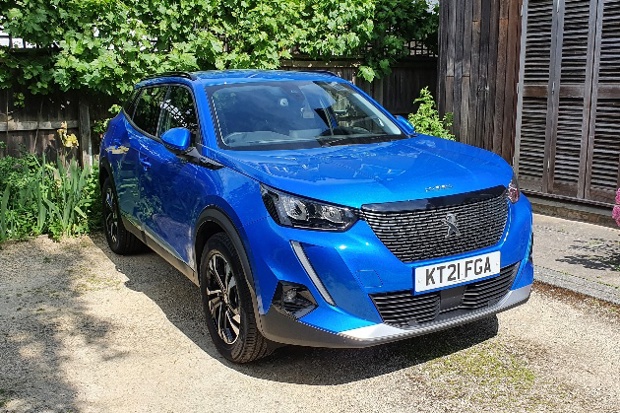
Date: 21 June 2021 | Current mileage: 312 | Claimed economy: 45.2-52.6mpg | Actual economy: 42.4mpg
This is the new Peugeot 2008. And it's causing quite a stir on my street in Cambridge. In fact, I haven't seen this much curtain twitching since 2014 when I was testing the (then) brand new Audi TT. Clearly, there is something special about Peugeot's latest small SUV.
The all-new 2008 is a handsome thing. And it looks all the better in Peugeot's striking Vertigo Blue pearlescent paint. Not everyone will warm to the 2008's huge front grille but I think the design has a lot going for it.
My Peugeot is powered by the familiar three-cylinder 1.2 PureTech petrol engine. In my 2008, it develops 130PS and returns 45.2-52.6mpg, according to the official numbers. However, I've decided to go for the auto version of the 2008 by specifying the eight-speed EAT8 torque converter gearbox, along with a handful of optional extras that bring this car in at a considerable £27,575.
The Peugeot 2008 is not a cheap car. Prices start in the region of £21,000 for the Active Premium 1.2 PureTech 100 manual and rise to around £36,000 for the electric GT Premium model after you've deducted the plug-in car grant. That puts it up against some serious premium competition, which includes the Audi Q2 and Volkswagen T-Roc.

I've resisted the urge to go for the range-topping GT mode (it would have pushed the list price to over £30,000). Instead, I've opted for Allure Premium, which sits in the middle of the line-up and will make up the majority of sales here in the UK. Equipment is pretty good, you get LED headlights and 17-inch wheels included, along with touchscreen infotainment and Peugeot's snazzy 3D iCockpit driver's display.
Navigation isn't included, but you do get Android Auto/Apple CarPlay. But unlike some of its rivals, you don't get the wireless system that's being rolled out across the line-ups. Instead, you have to plug your phone in via a USB lead to activate (in my case) Android Auto.
It's early days, but the 2008 has impressed on a handful of long journeys. The ride quality is soft and the 1.2 PureTech engine is smooth and quiet. The EAT8 gearbox is excellent on the motorway, too, providing slick up and downshifts at high speeds.
The 2008 is pretty good to drive with its small steering wheel providing lots of feedback through the bends. The front-wheel drive set-up also has lots of grip, which you can actually have some genuine engagement behind the wheel. So, all-in-all it's a positive start.
Out with the old and in with the new - why the 2008 SUV is the best yet
Is the new Peugeot 2008 SUV better than the old 2008 MPV?
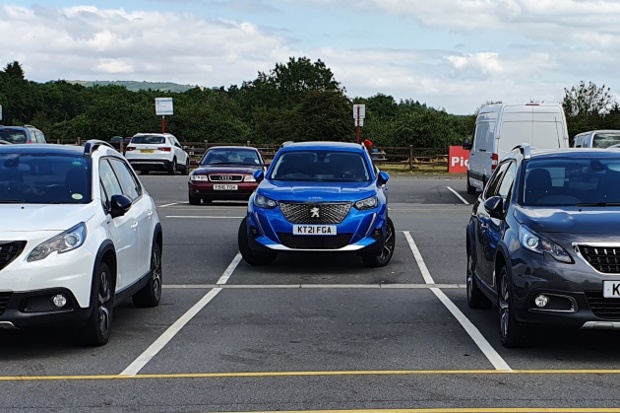
Date: 5 July 2021 | Current mileage: 890 | Claimed economy: 45.2-52.6mpg | Actual economy: 46.1mpg
I was never a fan of the old Peugeot 2008. I never warmed to its dumpy-styling and its lifeless, overpowered steering made it extremely dull to drive. What's more, with 360 litres of boot space, it wasn't actually that practical compared to alternatives like the SEAT Arona.
Clearly, I wasn't the only person who thought the old car was underwhelming because Peugeot went back to the drawing board with the new 2008.
The styling is a massive upgrade on the old car. The aggressive front-end gives the 2008 a somewhat menchingly appearance while its upright stance and sweptback headlights make it easy to mistake it for the larger 3008 from the front.
I still have reservations about the LED strips on the front bumper - they remind me of the fluorescent strip lights. And it's important to note that the 2008 doesn't get Peugeot's fancy '3-Claw' LED daytime running lights as standard, despite the fact they are featured in all of the car's publicity shots. This means, for most people, the fluorescent strips are the only bit of the car that'll light up during the day.

The 2021 Peugeot 2008 is a lot more practical than its predecessor with the boot providing 74 litres more storage. The high roofline and adjustable boot floor also makes it easy to load bulky items in/out. And the rear seats are easier to flatten with the push of a button, too.
The interior feels sturdy. There are no worrying rattles or squeaks from the plastics that I've experienced in the Peugeots of old. The seats are also supportive and comfortable, but there's no lumbar adjustment. If you do want a little lever to adjust the lumbar support then you'll need to buy the 2008 in GT spec and then pay an extra £1500 for the leather seat pack - ouch.
The biggest difference between the new and old 2008, however, is in the way the two cars drive. The 2021 2008 is much sharper, with lots of steering wheel feedback and very little body roll in the corners. The latest 1.2 PureTech 130PS engine is also more willing, which means the 2008 is very willing on a twisty A or B road.
Reinventing a car is no easy task - many have tried and failed. But the 2008 is a car that represents Peugeot's progress in recent years. Like the 3008 and 5008, it's a stylish and comfortable car that gives its premium rivals a lot to think about.
Stop-start problems with the 2008
The Peugeot 2008 has some very likeable traits. Sadly its EAT8 gearbox isn't one of them.

Date: 19 July 2021 | Current mileage: 1450 | Claimed economy: 45.2-52.6mpg | Actual economy: 46.3mpg
The Peugeot 2008 is a car that excels and frustrates in equal measures. I've grown to love the 1.2 PureTech petrol engine but the slow stop-start system and juddery EAT8 gearbox is driving me up the wall.
Peugeot's EAT gearboxes have a big following with car buyers who want a 'proper' torque converter gearbox. Not only do these transmissions have a very good reputation for reliability but they are usually smooth and refined - which is why they are used in expensive cars like the BMW 7 Series.
The EAT8 gearbox is brilliant on the motorway. It's fine above 15mph, too. But being a torque converter transmission it has a lot of low-gear torque and this makes it unrefined and nervous at low speeds with the car lurching forward as you lift your foot off the brake. Admittedly, you do get used to its mannerisms after a while but there is no hiding from the fact that the EAT8 gearbox is extremely harsh at low speeds.
The juddery nature of the gearbox is made all worse by the painfully slow stop-start system which is the worst I’ve experienced in a car for a very long time. In fact, it's so bad, I’ve now taken to switching it off at the start of every journey.

Problems with the stop-start system in the 2008 occur as you slow down, with the system kicking in at the very earliest opportunity. This can give the sensation the car is stalling as you approach a junction or roundabout as it strangles the life out of the engine. And the system takes two or three seconds to start the engine again, which means you will be sitting stationary as the traffic around you starts to move again.
Things are even worse on the hills because stop-start doesn't seem to work in harmony with hill-hold assist. And this means the car will, on occasions, start to roll backwards as you press the throttle and wait for the engine to restart. Admittedly, the roll back distance is measured in a couple of centimeters. But it's more than enough to send a wave of alarm through your senses.
Thankfully you can switch off the stop-start system with the press of a button on the infotainment screen. But you can't disengage it permanently, which means you have to remember to do this at the start of each journey.
It's a real shame. The 1.2 PureTech engine is one of the best three-cylinder units out there. Smooth, punchy and super quiet, it's a peach of a petrol engine. It just needs a stop-start buddy that's up the task.
When should you change the cam belt on the Peugeot 1.2 PureTech?
Cam belt questions are very common here at HonestJohn.co.uk, but the answer for the 2008 is anything but simple.
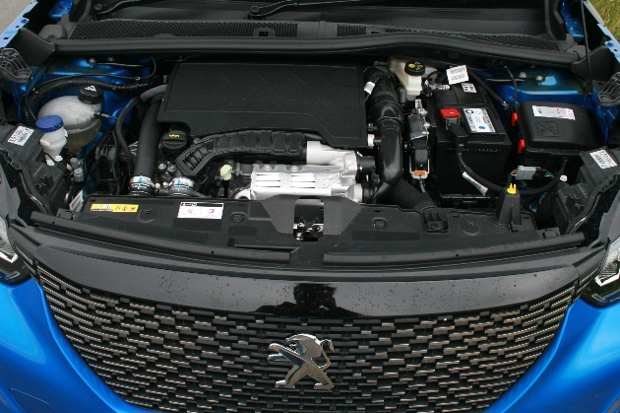
Date: 3 August 2021 | Current mileage: 2098 | Claimed economy: 45.2-52.6mpg | Actual economy: 46.4mpg
When should you change the cam belt on the Peugeot 1.2 PureTech petrol engine? Confusion around cam belt changes are common but the answer for the 1.2 petrol engine in the 2008 is anything but straightforward.
The cam belt - or timing belt to use its correct term - plays a vital role in the operation of your car because it controls the timing of the engine and prevents the pistons and valves in the cylinders from smashing into one another.
Not all engines use cam belts - some use chains which are lubricated by the engine oil and are designed to last the life of the car. Obviously, avoiding costly belt changes is something that's seen as a big bonus for car buyers. That's why some manufacturers, like Peugeot, have started to use a 'wet belt' system for their petrol engines which protects the belt by lubricating it with oil and allowing it to last much longer than a conventional system.
As a general rule, I recommend a cam belt change every 60,000 miles or five year (whichever comes first). This is because most failures we hear about occur when the cam belt is past these milestones. And take it from us, the impact of a cam belt failure on an engine is usually terminal.

The 1.2 PureTech is one of these wet belt engines. However, while some of Peugeot's wet belt rivals promise up to 10 years or 150,000 miles of trouble-free motoring on the same cam belt, the 2008 and its 1.2 PureTech will only go up to 60,000 miles and/or six years before it needs to be replaced.
What's more, because the 1.2 PureTech engine uses a special belt in the oil system, the cost to replace it is higher, with dealers quoting a minimum of £500. In comparison, a standard cam belt in a small car will set you back £300 at a local garage or around £400 at a dealer.
Now I don't know why the 2008's wet belt system requires a change every 60,000 miles or six years (whichever comes first). But I do know from the feedback we have received via ASK that some Peugeot owners have suffered problems with the timing belts in the older versions of the 1.2 PureTech engine. Perhaps these issues have prompted Peugeot to err on the side of caution.
But to answer the original question, when should you change the cam belt on the Peugeot 1.2 PureTech petrol engine? Every 60,000 miles or six years (whichever comes first). Just don't expect it to be a cheap job.
Peugeot Connected 3D Navigation - do you really need it?
Want your 2008 with Connected 3D Navigation? You'll need to spend £650 extra. But Apple CarPlay and Android Auto makes it redundant, says Dan.
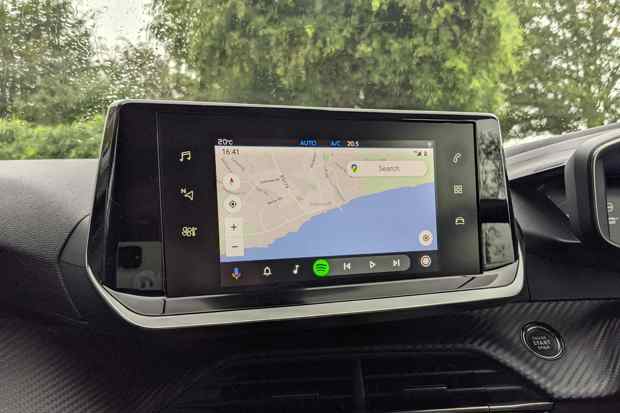
Date: 17 August 2021 | Current mileage: 2323 | Claimed economy: 45.2-52.6mpg | Actual economy: 46.2mpg
There was a time when touchscreen navigation was the must-have option for all new cars. Easy to use and capable of providing live traffic updates, manufacturer navigation systems have been a revelation for drivers. But they have seldom been cheap to buy.
Thankfully you do not need to spalsh to cash to get a brilliant sat nav. Because there is another option, in the form of Apple CarPlay and Android Auto. Both of these systems are easy to master; you simply plug your phone into the USB socket on the dashboard of your car and the infotainment screen will mirror your phone’s map display.
This means you can get all of the benefits of a fancy navigation system without the need to fork out hundreds extra on the car's spec. For example, the Peugeot 2008 gets a 7.0-inch touchscreen as standard. But if you want the Connected 3D Navigation then you’ll need to spend an extra £650 for it to be added to the system. Ouch.
To be fair to Peugeot, its 3D navigation system is powered by TomTom and it's very good. I’ve tried it on a number of models in the past and it provides excellent directions and crisp graphics that make it easy to follow. But I’m not sure it’s worth £650 over my phone’s Google Maps.

Sadly, unlike some of its rivals, the Peugeot 2008 doesn't have wireless mobile phone connectivity for Android Auto and Apple CarPlay. This means you have to spend £20 on a high-quality phone USB lead and make sure it's in the car at all time. And this can be a bit of a faff, if I'm honest.
Android Auto has made manufacturer map systems somewhat redundant. Not only is Google Maps better to use but its traffic alerts are also more accurate, which means you won't be sent on a huge diversion to avoid a road jam that cleared hours ago. You also get the benefit of accessing your favourite music sharing apps, which means you can select songs with voice control.
That said, the 2008 does still have a few tricks of its own. The Allure Premium spec includes the excellent 3D i-Cockpit system as standard. This configurable instrument panel gives you a multilayer display for speed, fuel and pretty much anything else you can think of. It's really attractive to the eye and super easy to read at night.
The 1.2 PureTech petrol engine is also easy on the wallet. Average fuel economy has stuck around the mid-40s for a few weeks now and this means the 2008 is affordable on fuel. The three-cylinder engine is also super quiet on the motorway, which means you will only hear the engine when overtaking traffic or joining a fast moving motorway. All things considered, the 2008 is an impressive little crossover.
Why are small SUVs like the 2008 so popular?
Small SUVs are in high demand and you don't need to be a car expert to see the appeal, says Dan.
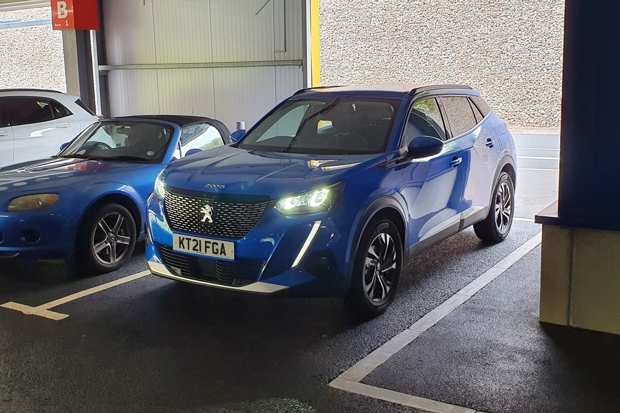
Date: 31 August 2021 | Current mileage: 2907 | Claimed economy: 45.2-52.6mpg | Actual economy: 46.2mpg
Small SUVs and crossovers have never been more popular. In 2020, two of the top 10 best-sellers in this country were small SUVs and 2021 is looking like it'll be another bumper year for these boxy cars. But why are SUVs so popular with buyers in the UK?
Big SUVs might be the cars that everyone loves to hate, but there is no denying the fact they are often more practical and comfortable than rival hatchbacks and saloons. Much of this is down to the fact that SUVs have a higher driving position, which means getting in and out doesn’t require as much effort or strain on the joints.
As well as being popular with older drivers and people with mobility issues, SUVs also hit the sweet spot for parents with young children, as you don’t have to bend down to lift out your child from the rear seat or risk hurting your back when lifting a buggy from the boot.
Small SUVs provide all of these benefits, with the added bonus of being roughly the same size as a small hatchback. This means they are easier to park, cheaper to fuel and generally more fun to drive than their larger counterparts.

The 2008 is a really good example of a good, compact SUV. Based on the excellent 208, the 2008 is good to drive. In fact, it’s really good to drive, with direct and responsive steering that provides lots of feedback. The handling is nimble while the front-wheel drive set-up provides lots of grip and this means it's easy to build confidence behind the wheel.
It’s a comfortable car too. All Allure Premium models run on 17-inch alloy wheels, but the tyre profile is quite high, at 60, which means the tyres do a pretty good job of absorbing lumps and bumps from the road. The suspension is quite soft, which again makes long journeys a pleasant expereince.
Peugeot has really got the balance right with the mechanical setup of the 2008 and it’s rare for an SUV to combine strong handling with good road comfort - but Peugeot has done it here. And the 2008 is fast becoming one of Peugeot's best-selling cars.
Running costs in my 2008 remain affordable with fuel economy averaging in the mid-40s. When I ordered the 2008 I was more than a little worried about mpg, as I assumed the three-cylinder 1.2 PureTech engine would struggle with the 2008's weight. But so far sky-high fuel bills have failed to materialise, which means real world mpg is generally reflective of the advertised economy of 45.2-52.6mpg.
Sofa, so good - why the 2008 is the small SUV with the big boot
The Peugeot 2008 has a large and useful boot that will carry large items with ease.
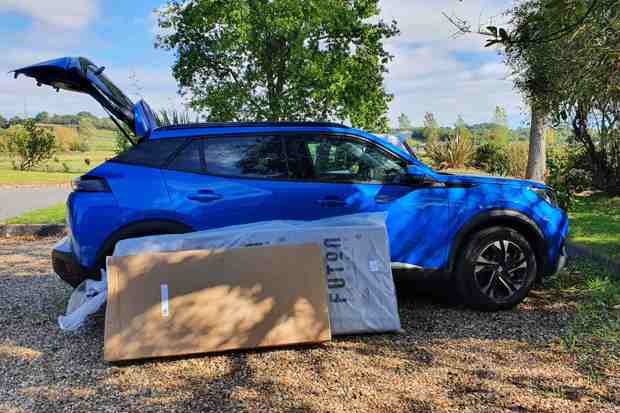
Date: 14 September 2021 | Current mileage: 3206 | Claimed economy: 45.2-52.6mpg | Actual economy: 45.1mpg
The Peugeot 2008 is the small SUV that’s full of surprises. For example, did you know it’s possible to fit a three-seater sofa in the back of a 2008? No, neither did I.
If truth be told, the 2008 was never meant to be drafted into action as a furniture van. My girlfriend had ordered a flatpack three-seater from a local store and I was hoping to use a Skoda Superb Estate, which I had on test for a week.
Sadly a delay to the delivery pushed the sofa arrival date back by a few weeks and I was left with the choice of paying a £30 delivery fee or attempting to shoehorn the thing into the 2008; naturally, being a cost-conscious journalist, I chose the latter.
I won’t lie, I never really expected a car that’s based on the 208 hatchback to really succeed here. Yet, much to the surprise of myself and the store manager who helped me huff and puff the sofa into the back of the car, the 2008 came up top trumps.

The 2008 is deceptively large. The car itself measures just 4300mm in length, but it conceals a practical interior that is extremely useful for moving large and bulky items. For example, when you lower the rear seats you get a load space that measures 1800mm from the boot lip to the back of the front seats.
The LED interior lights also make loading things in/out ridiculously easy, especially at night. After unloading our new sofa I realised I’d lost a packet of screws inside the Peugeot. But finding them, buried in the rear footwell was easy, thanks to the fact you get four ultra bright LED lights as standard.
Making full use of the 2008’s interior is straightforward: simply press the button on the shoulder of each backrest and they automatically fold down. You also get a 60/40 split, which means you can carry large items and a rear passenger or two, depending on your needs. The only downside is the fact the seats don’t fold flat.
You also get a decent amount of space with the rear seats in place, too. Recently a friend asked me to help him collect some ice for a large house party he was hosting. The 2008 managed to pack an incredible 80kg of the stuff at the supermarket, which made my plucky Peugeot one of the many toasts expressed over the evening.
Peugeot i-Cockpit 3D review
The 2008 is fitted with Peugeot i-Cockpit as standard, is it better than traditional dials?

Date: 28 September 2021 | Current mileage: 3639 | Claimed economy: 45.2-52.6mpg | Actual economy: 45.2mpg
Peugeot's i-Cockpit system has often been seen as the Marmite of car interiors, with drivers loving or hating it in equal measure - and for many years I have sided with the latter.
What is i-Cockpit, I hear you ask? In theory, it's a dashboard layout that's intended to give the driver class leading comfort, along with a perfect view of the road and instrument display. In reality, however, it could often be the complete opposite.
Being a tall chap, I would often struggle to find a comfortable driving position. Set the steering wheel too high and it'll partially obscure the instrument display. Set it too low and you'll end up injuring yourself when making a sharp turn.
Thankfully, with the latest i-Cockpit system, many of these problems have been solved with the introduction of a smaller steering wheel.
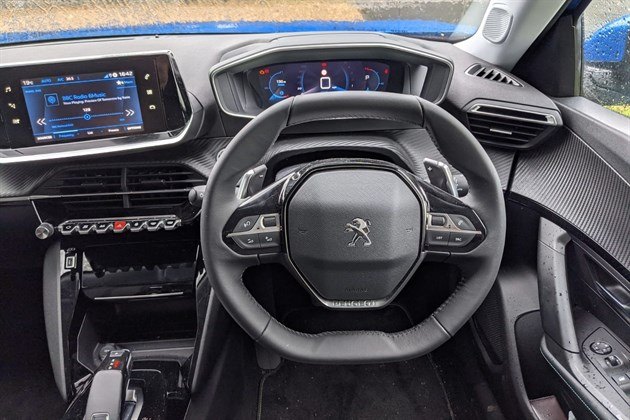
The small steering wheel design is brilliant. It's super comfortable and perfectly designed for your hands, with the leather stitching acting as finger grips all along with the interior of the wheel. What's more, due to its compact size and direct nature, you don't need to make dozens or turns to encourage the car into a parallel parking space.
All versions of the 2008 are fitted with the i-Cockpit. But only Allure Premium models, seen here, get the digital 3D display. And it really makes a world of difference to the 2008 driving experience, with the clear and crisp screen making it easy to read, day or night.
The display is fully customisable, which means you can change the layout to focus on the vehicle speed, revs or fuel economy. You can also get a G-meter, although I'd question its usefulness in a 1.2-litre petrol SUV with 130PS...
The i-Cockpit system is offset by the slow touchscreen that's located at the centre of the dashboard, which can make it fiddly to adjust the air con and/or cabin temperature. But it's certainly better than the digital dash systems found in the Ford Puma and Nissan Juke.
Peugeot 2008 - Allure Premium or GT?
Which trim level should you choose when buying a new 2008? Dan thinks the GT line might be best.

Date: 12 October 2021 | Current mileage: 4190 | Claimed economy: 45.2-52.6mpg | Actual economy: 44.6mpg
It feels like I am the only Peugeot 2008 driver in the UK who didn't choose the range-topping GT trim line. Don't get me wrong, I'm very happy with the level of equipment in the Allure Premium spec, but it does get shown up on a regular basis by the pricey but eye-catching GT.
When putting together the factory order for this 2008 I decided against the GT model because it seemed too expensive, adding a considerable £2300 to the list price. And that means, with a few options, my 2008 would have come in at a whopping £29,875.
Yet, whenever I see a 2008 on the road, it is always finished in the GT trim line. Indeed, only last week, I returned to my 2008 in a multistory to find a GT model parked next to me. And boy, does it put the Allure Premium car to shame.
Yes, I know, I'm going green with envy here, but the GT spec does give the 2008 a real edge in the looks department. Especially when finished in Orange Fusion metallic paint (which is a no-cost paint option).

The more I think about it, the more I start to realise that I may have made a mistake with my choice of spec. It actually makes a lot of sense to go GT if you want things like factory-fit navigation with the larger 10-inch screen, interior ambient lighting and heated seats fitted as standard.
GT drivers get the smart 3-claw LED daytime running lights, too, along with the black roof and spoiler that gives the 2008 something of a hot hatch appearance. And as you can see from the pictures, it does look a whole lot better.
Obviously, if you don't care a jot about flashy trims and a massive touch screen then the Allure Premium model will be more than sufficient for your needs. But the key thing is to work out what you actually want from your car first, as the options may take the list price extremely close to the GT model.
Wherever version you choose, it's unlikely you will be disappointed. The 2008 has really impressed these past four months and it's easy to see why it's become such a hit with car buyers. Easy to drive, comfortable and stylish, it's one of the best compact SUVs on sale today.
Touchscreen car controls are a pain in the 2008
Every 2008 is fitted with a touchscreen infotainment system, but the entry-level tech is below average according to Dan.

Date: 26 October 2021 | Current mileage: 4500 | Claimed economy: 45.2-52.6mpg | Actual economy: 44.3mpg
I have something of a love-hate relationship with the 2008's infotainment system. I love the innovative i-Cockpit 3D system but I've grown to hate the seven-inch screen that sits in the middle of the dashboard.
Fiddly to use, slow and displayed on a narrow, letterbox-style seven-inch screen, the infotainment system is a poor match for the wonderful digital instrument binnacle that shines brightly behind the steering wheel.
Like many modern cars, the 2008 has integrated a lot of its key controls into the touchscreen. As a result, there are no buttons or dials for the heating controls. You can't switch off the infuriating stop-start system either, without tapping furiously on the infotainment screen to find the required settings page.
The system also doubles up as the display for the reversing camera. But the camera seems to have a life of its own, occasionally refusing to work. This means the screen goes blank as you start reversing and you're required to use the parking sensors alone.

The 2008 does have some button controls, which sit below the central air vents and use a piano key design, similar to the 3008 (pictured above). You also get a volume dial, but its location makes it easy for the passenger in the front to catch it with their knee. This means the volume may suddenly increase/decrease each time your passenger moves their right leg.
You could avoid a few of these issues by spending an extra £950 on the 10-inch infotainment system that has faster screen changes and a better HD display. Or you could upgrade to the 2008 in GT trim, which gets the 10.-inch screen as standard.
Small complaints aside, the 2008 remains an impressive package. The fuel economy remains steadfast in the mid-40s, and this doesn't really change all that much when you add passengers and luggage.
But the small SUV market is super competitive. And I do question if some buyers might find the infotainment frustrations to be a dealer breaker. What do you think? As always, you can give us your feedback via ASK HJ or by writing an owner's review.
Peugeot 2008 vs Ford Puma - which is best?
Is the Peugeot 2008 better than the big-selling Ford Puma? Dan compares the two to find out.

Date: 9 November 2021 | Current mileage: 4681 | Claimed economy: 45.2-52.6mpg | Actual economy: 44.2mpg
The Ford Puma is the UK's best-selling small SUV. And it is perhaps the number one reason why more people don't buy a Peugeot 2008.
Since its relaunch in 2020, the Puma has become a huge success for Ford. In fact, the Puma is on track to displace the Fiesta as Ford's best-selling car in the UK - something that hasn't happened since (fittingly) 2008 when the Focus was number one.
Cheaper to buy, better equipped as standard and sharply styled, the Puma asks some serious questions of the 2008. The Puma also has a reputation for being better to drive, while its 456-litre boot is more practical than the 434 litres you get in the Peugeot - thanks to Ford's 'megabox' design that utilises the space under the boot floor.
Having driven both cars, I can confirm that the Puma is more engaging behind the wheel. Not only is the steering sharper and better weighted, but the Puma also feels firmer which means it doesn't roll into the corners as much as the softer sprung Peugeot. The 1.0 EcoBoost engine is an upgrade, too, thanks to its mild hybrid tech that provides a sharper throttle response.

Usually, when a car is sharper to drive, it means you will get poorer fuel economy. But that shouldn't be the case with the Puma. The 125PS version of the 1.0 mHEV auto promises 48.7 - 49.6mpg, while the feisty 155PS is advertised between 47.9 - 48.7mpg. That's more than equal to the advertised figures of the 2008.
To be fair to Peugeot, the build quality of the interior of the 2008 is much better than the Puma. The materials are plusher and the seats are more comfortable. But again Ford takes an edge here because the cabin is easier to use with physical buttons for things like heating and ventilation. You also get better value, with a mid-spec Puma ST-Line having navigation, a heated windscreen and lumbar adjustment for the driver's seat as standard.
As you have sensed, the Ford and Peugeot comparison isn't going all that well for the 2008. And things don't really get any better when you compare prices, either. The Puma 1.0 mHEV 125PS auto in ST-Line trim starts at £25,885 - which is £345 less than the 2008 here in Allure Premium.
Despite all of this, the Peugeot 2008 is not a bad car. It's a very good one in fact. But, as an overall package, the Puma has the edge over its French rival. And if I was a buyer, I probably wouldn't leave the Ford showroom without putting down a sizable deposit on the Puma. Sorry Peugeot...
The pros and cons of Peugeot 2008 ownership
It's the end of the road for Dan and his long term test car. What's his verdict on the 2008?
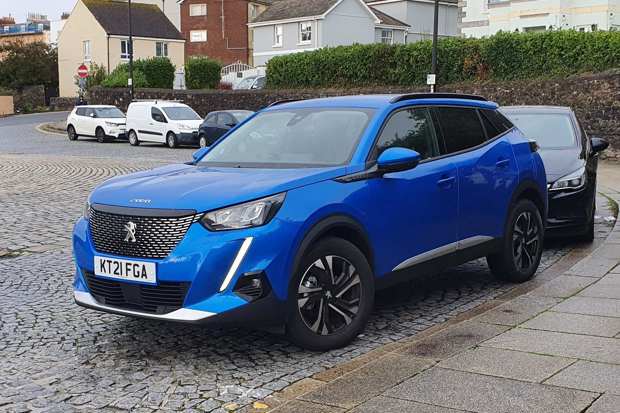
Date: 23 November 2021 | Current mileage: 4870 | Claimed economy: 45.2-52.6mpg | Actual economy: 42.0mpg
Is the Peugeot 2008 a good SUV? More importantly, should you consider buying one if you are in the market for a compact and comfortable crossover? After six months and almost 5000 miles, the time has come for me to reflect on my Peugeot 2008 experience. Most of it has been good, but the test hasn't been without its issues...
First, let's focus on what makes the 2008 an excellent car. The 1.2 PureTech engine is a real peach, with smooth performance and excellent refinement. It is also pretty good on fuel, averaging around 42mpg during its time with the Powell household.
The EAT8 automatic gearbox is a little rough around the edges but it's mostly impressed with excellent highway manners and intelligent anticipation on both the up and downshift. The only criticism I can level at the EAT8 is its snappy nature at low speeds, although this is a characteristic for most torque converter gearboxes.
The 2008 is comfortable on 17-inch wheels - thanks to its deep profile tyres - and this means rough roads and potholes are generally dispatched with a barely noticeable thud. The road handling is also surprisingly good, with the perfectly balanced steering and responsive chassis set-up giving the 2008 some genuine driver engagement when cornering at speed.

I do like the 2008's interior: it’s upmarket and spacious. The 2008 will comfortably carry four adults while the 434-litre boot will handle three or four large suitcases - the adjustable floor means you don't have to crack your back to lift heavy things in and out, either. Importantly, the boot provides an 1800mm load length when you lower the rear seats, which means the 2008 is useful for those trips to the local tip.
But what's bad about 2008? Well, the stop-start system is awful. I mean, really awful. Not only does it cut in and out at the worst times, but it fails to fully engage with the hill-hold systems and this has a tendency to ruin the driving experience at low speeds.
The minimalist dashboard is also difficult to live with, due to the fact the heating and ventilation buttons are buried away in the touchscreen controls. I also found the seven-inch screen to be a bit of a faff to use, due to its narrow display and slow screen changes. If I had my time again with the 2008, I'd have probably gone with the GT model and its excellent 10-inch screen.
However, as an all-around package, the 2008 is a very good car. And one of Peugeot's best-selling models in Europe, thanks to its smart styling and low running costs. The quality of the interior also sets new benchmarks for the small SUV class, which means you generally feel like you are driving a much more expensive car. And when you factor in the affordable running costs, it's easy to see why the 2008 is such a winner for Peugeot.
